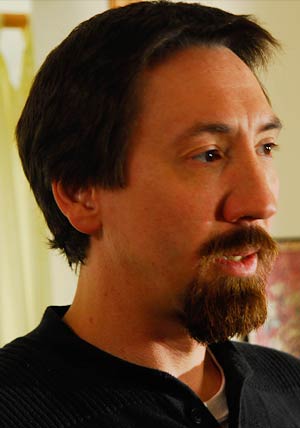Marrow
The Director
Biography
Matt Wilkins was born in Scott County, Iowa and moved to Seattle in 1992. His first grant came from the Seattle Arts Commission. With that, he made a super-8 silent black and white comedy, “The Gods Looked Down and Laughed.” This work led to a grant from the King County Arts Commission and his second film, “Interior Latex,” which played 21 festivals and venues, including Italian television RAI Uno, and won a Judges’ Award from Simpsons creator Matt Groening at the NW Film and Video festival in 1999. He was selected as the year 2001 Start-To-Finish Grant recipient from the NW Film Forum, which helped make his first feature film, “Buffalo Bill’s Defunct—Stories from the New West.” After premiering at the Seattle International Film Festival in 2004, it played the Smithsonian Institute’s Museum of American History in Washington, D.C. in April of 2005.
His second feature “Marrow” was funded with two grants from 4Culture, two from Artist Trust, and one from MOACA. “Marrow” is currently in post-production and Matt is developing a script for his third feature, “Clean Sheets.” In between features, Matt makes short films, including “McMullen’s Machines,” which played Sundance 2010 as part of MTV’s “$5 Cover” presentation.
Matt lives with his wife Eliza and son Wiley in Tukwila, WA, and works as a field producer and writer on the A&E show “Hoarders.”
Director's Statement
My stories are inspired from personal experience — incidents that happened to me, or that I witnessed, or occasionally anecdotes I heard through the grapevine. I like stories that I’m instinctually attracted to — stories that I don’t completely understand at first, but that have a magnetic pull.
I make a type of film that might be described as “open-frame” or “pragmatic realist,” relying on non-verbal, behavioral forms of communication, rather than dialogue, and a dogmatic approach to the written word. Together, my actors and I try to create rounded characters that live and operate in the real world, which I believe contains endless fascination.
I want to capture truthful performances and am highly tolerant of variety and inconsistency. If the actors are focused on their actions and their interactions, if they are being and doing, and creating authentic behavior under imaginary circumstances, as Sanford Meisner suggests, then straying from the dialogue in the script can actually be a good thing. Since film can be edited, the greatest moments of various takes and tangents can be re-woven into a meaningful whole.
Visually, I believe in the maxim that “form matches content.” If the story is about a broken-down old man, the film should look a little rickety. If the story is about a woman haunted by her memories, the visual style should connote those feelings. Rather than forcing a style onto the world, I let the world and the subject matter fashion the style, so that I blend in with my environment.
As an artist who makes films, I have a strong desire to connect with audience members who are sensitive to subtlety and who are open to new challenges. I know of no greater feeling of accomplishment than to affect like-minded strangers on an emotional level, to make a handful of friends in a single screening.

